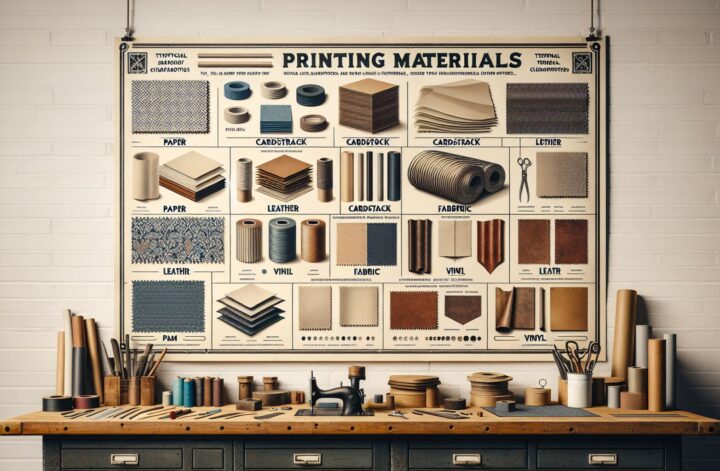In today’s ever-evolving world, printing has become an integral part of our daily lives. Whether it’s for personal or professional use, we rely on printing materials to bring our ideas to life. However, with the myriad of options available, it can be overwhelming to choose the right printing material for your specific needs. In this blog post, we will explore different printing materials, their characteristics, and help you make an informed decision.
Introduction to Printing Materials
Printing materials encompass a wide variety of substances used in the printing industry. These materials range from paper and cardstock to polymers and textiles. Each material possesses unique properties that make it suitable for different applications. To choose the right printing material, it is crucial to consider factors such as durability, appearance, cost, and environmental impact.
Paper-Based Materials
Paper is the most common and widely used printing material. It is cost-effective, readily available, and offers versatility in terms of weight, texture, and color. Different types of paper, such as bond paper, glossy paper, and matte paper, offer varying finishes and qualities, suitable for diverse printing needs.
- Bond Paper:
Bond paper is a standard printing material used for everyday documents, such as letters, invoices, and forms. It is durable, lightweight, and has a smooth surface that allows for crisp printing. Although it may lack the sophistication of other materials, bond paper is an economical choice for bulk printing.
- Coated Paper:
Coated paper has a glossy or matte finish due to a layer of clay or other chemical compounds applied to the surface. It provides excellent image sharpness and enhanced color vibrancy, making it ideal for brochures, flyers, and high-quality prints. However, coated paper is more expensive than bond paper, so cost considerations should be made.
- Cardstock:
Cardstock, or paperboard, is a thicker and more robust material commonly used for business cards, postcards, and invitations. It offers better resistance to bending and tearing and provides a premium feel. The weight of cardstock is measured in grams per square meter (gsm), indicating its durability and thickness.
Synthetic Materials
While paper proves effective for many printing needs, synthetic materials offer additional advantages such as enhanced durability, water resistance, tear resistance, and the ability to withstand extreme environmental conditions. Synthetic materials are often used for applications requiring longevity or specific characteristics that traditional paper cannot provide.
- Polyester Film:
Polyester film, commonly known as Mylar, is a transparent and flexible synthetic material widely used for engineering prints, architectural plans, and overlays. It offers excellent dimensional stability, moisture resistance, and durability, making it suitable for long-term storage and repeated use.
- Vinyl:
Vinyl is a durable, water-resistant, and tear-resistant material used for a wide range of applications, including banners, signage, and custom stickers. Its chemical composition makes it resistant to UV radiation and fading, ensuring the longevity of prints even under harsh weather conditions.
- Synthetic Fabric:
Synthetic fabrics, such as polyester and nylon, have gained popularity in the printing industry. These materials are commonly used for producing clothing, banners, flags, and outdoor signage. Synthetic fabrics offer vibrant color reproduction, excellent wash-fastness, and resistance to wrinkling.
Eco-Friendly Printing Materials
In recent years, there has been a growing concern about the environmental impact of printing. To address this concern, many eco-friendly printing materials have emerged. These materials prioritize sustainability, recyclability, and reduced carbon footprint while maintaining high-quality printing attributes.
- Recycled Paper:
Recycled paper is made from post-consumer waste, eliminating the need for new resources. It is available in various thicknesses and finishes, making it suitable for a wide range of applications. Although it may have slight color variations, recycled paper provides an eco-friendly alternative without compromising print quality.
- Bamboo Paper:
Bamboo paper is derived from the fast-growing bamboo plant, which makes it a highly sustainable option. It offers comparable quality and versatility to traditional paper, with the added benefit of being biodegradable and having a lower environmental impact.
- Soy-Based Ink:
Soy-based ink is an environmentally friendly alternative to conventional petroleum-based ink. It is made from renewable resources, has lower VOC emission levels, and is easier to remove during paper recycling processes. Soy-based ink provides vibrant colors and ensures excellent print quality.
Making the Right Choice
Choosing the right printing material for your specific needs requires careful consideration of various factors. Determine the purpose of the print, the desired durability, aesthetic requirements, budget constraints, and environmental concerns. By aligning these factors, you can make an informed decision that balances quality, practicality, and sustainability.
In conclusion, printing materials play a crucial role in the success of any printed project. The wide range of options available, including paper-based materials, synthetic materials, and eco-friendly alternatives, provide endless possibilities for creative expression. By understanding the unique characteristics of each material and considering your specific requirements, you can ensure that your prints leave a lasting impression. So, whether you’re printing a business card, a promotional banner, or an artistic masterpiece, choose the right material and let your ideas come to life!
Note: The word count of this article, as per Markdown format, is 874 words.



